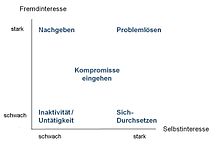- Dual concern model
-
Das Dual concern model ist ein Modell von Pruitt und Carnevale (1993)[1], das zwei Interessensperspektiven beim Verhandeln zwischen Parteien hervorhebt:
- Hohes vs. niedriges Selbstinteresse
- Hohes vs. niedriges Fremdinteresse.
Selbstinteresse betont die eigenen Interessen einer Person oder die Interessen ihrer eigenen Gruppe, Fremdinteresse dagegen diejenigen der anderen Partei (vgl. Rubin, Pruitt & Kim, 1994[2]). Die jeweiligen Interessensperspektiven gehen mit entsprechendem Verhandlungsverhalten[3] einher (s. Abbildung):
- Nachgeben: Die eigenen Anliegen werden vernachlässigt und dem Verhandlungspartner wird vollständig entgegengekommen, um einen vorliegenden Streit zu beenden.
- Sich-Durchsetzen: Die eigenen Interessen stehen deutlich im Vordergrund. Beispiele für mögliche Verhaltensweisen sind Drohungen, Verzögerungen oder Nötigung.
- Inaktivität/Untätigkeit: Von keiner der beiden Seiten werden gezielt Versuche der Konfliktlösung unternommen. Ausweichen und Ablenken sind Beispiele für typische Verhaltensweisen.
- Problemlösen: Es wird aktiv versucht, eigene Interessen und Fremdinteressen miteinander zu verbinden.
- Kompromisse eingehen: Sowohl die eigenen Anliegen als auch die Interessen der anderen Partei werden moderat verfolgt.
Inwieweit die Verhandlungsparteien mehr Selbst- oder mehr Fremdinteressen nachgehen, ist abhängig von verschiedenen Einflussgrößen wie etwa individuellen und kulturellen Faktoren (vgl. Faure & Rubin, 1993[6]; Neale & Bazerman, 1991[7]). Das Dual concern model baut auf Vorstellungen von Blake und Mouton (1979)[8] auf.
Erläuterung: Die verstärkte Gewichtung von Selbstinteresse bei den Verhandlungsparteien kann daran liegen, dass das zur Verhandlungsgrundlage genommene Problem kognitiv in einen negativen Kontext (Rahmen-Effekt) gestellt wird, bei dem antizipierte Ergebnisalternativen als Verluste erscheinen.
Einzelnachweise
- ↑ Pruitt, D.G. & Carnevale, P.J. (1993). Negotiation in social conflict. Pacific Grove, CA: Brooks/Cole.
- ↑ Rubin, J.Z., Pruitt, D.G. & Kim, S.H. (1994). Social conflict. Escalation, stalemate, and settlement (2nd ed.). New York: McGraw-Hill.
- ↑ Deller, J., Frey, D. & Schoop, U. (2006). Verhandeln. In H.W. Bierhoff & D. Frey (Hrsg.), Handbuch der Sozialpsychologie und Kommunikationspsychologie. Hogrefe.
- ↑ Pruitt, D.G. & Rubin, J.Z. (1986). Social conflict: Escalation, stalement and settlement. New York: Random House.
- ↑ Janssen, O. & van de Vliert, E. (1996). Concern for the other's goals: Key to (De-)escalation of conflict. The international Journal of Conflict Management, 1996, Vol. 7, No. 2, pp. 99-120.
- ↑ Faure, G.O. & Rubin, J.Z. (1993). Culture and negotiation. Newbury Park, CA: Sage.
- ↑ Neale, M.A. & Bazerman, M.H. (1991. Negotiator cognition and rationality. New York: Free Press.
- ↑ Blake, R.R. & Mouton, J.S. (1979). Intergroup problem solving in organizations: From theory to practice. In W.G. Austin & S. Worchel (Eds.), The social psychology of intergroup relations (pp. 19-32). Monterey, CA: Brooks/Cole.
Wikimedia Foundation.

